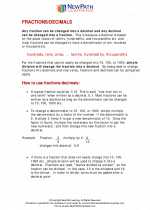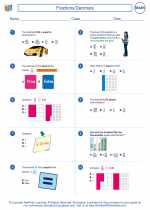Fractions/Decimals Study Guide
Fractions
A fraction represents a part of a whole. It consists of a numerator (the number on top) and a denominator (the number on the bottom). For example, in the fraction 3/4, 3 is the numerator and 4 is the denominator.
Equivalent Fractions
Equivalent fractions are different fractions that represent the same part of a whole. To find equivalent fractions, you can multiply or divide the numerator and denominator by the same number.
Adding and Subtracting Fractions
To add or subtract fractions, first make sure the denominators are the same. Then, simply add or subtract the numerators and keep the denominator the same. If the denominators are different, you need to find a common denominator before performing the operation.
Multiplying and Dividing Fractions
To multiply fractions, simply multiply the numerators together and the denominators together. To divide fractions, you can multiply by the reciprocal of the second fraction.
Decimals
Decimals are a way of representing parts of a whole or parts of a group. The decimal point separates the whole number from the fractional part. For example, in the number 3.75, 3 is the whole number and .75 is the fractional part.
Converting Fractions to Decimals
To convert a fraction to a decimal, simply divide the numerator by the denominator. For example, to convert 3/4 to a decimal, divide 3 by 4 to get 0.75.
Converting Decimals to Fractions
To convert a decimal to a fraction, use the place value of the decimal. For example, the decimal 0.25 can be expressed as 25/100, and then simplified to 1/4.
Adding, Subtracting, Multiplying, and Dividing Decimals
When adding, subtracting, multiplying, or dividing decimals, align the decimal points and perform the operation as if working with whole numbers. Then, place the decimal point in the answer so that it lines up with the decimal points in the original numbers.
Practice Problems:
- Convert 3/5 to a decimal.
- Find the equivalent fraction of 2/3 with a numerator of 4.
- Add 0.6 and 0.25.
- Multiply 1/4 by 2/5.
Feel free to use this study guide to review and practice fractions and decimals. Good luck!
[Fractions/Decimals] Related Worksheets and Study Guides:
.◂Math Worksheets and Study Guides Sixth Grade. Fractions/Decimals

 Worksheet/Answer key
Worksheet/Answer key
 Worksheet/Answer key
Worksheet/Answer key
 Worksheet/Answer key
Worksheet/Answer key
